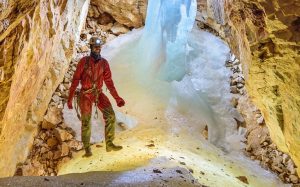I am looking for a candidate who will use mathematical modeling to study the functioning or development of a selected subsystem of our planet.
Karst regions are characterized by the solubility of their bedrock and a significant proportion of underground water flow. This results in distinctive geomorphological features that shape both the surface and subsurface, as well as unique and often surprising water flow patterns. Caves, predominantly found in karst regions, preserve ancient sediments while enabling access to them, providing crucial data. By analyzing these sediments, scientists have gained insights into the evolution of Earth’s surface, geological history, and past climate conditions. Caves host significant archaeological and paleontological sites, while the underground karst environment is an important habitat and a subject of intensive biological research.
Particularly interesting physical processes in the karst underground are the flow of heat and matter (air, water, carbon dioxide, etc.) and the evolution of karst underground. I highlight two key topics:
- Modeling the evolution of karst aquifers and cave formation. Numerous models already exist, but each one of them is limited to a small part of the parameter space. You could either expand the scope through modeling previously unexplored parameter values, or synthesize existing research into a more comprehensive framework. As computational complexity increases with improved accuracy, statistical approaches such as machine learning may help better utilize these computationally expensive results.
- Modeling the flow of air, water, or heat. While water flow has been studied a lot due to its commercial importance, the dynamics of air and heat have often been overlooked. Air circulation in karst systems regulates CO₂ concentrations. As CO₂ is a key driver of carbonate dissolution, this influences carbonate karst development to an important extent. Additionally, the relationship between subsurface and surface temperatures is important because cave sediments and speleothems serve as archives of past climatic conditions. A better understanding of how the local cave environment affects these climate proxies would enable more accurate reconstructions of past climate. Developing a model for air and/or heat circulation in a selected karst system would be a novel and valuable contribution. In addition to first-principles insights, such modeling may utilize empirical data, now easier and more precise to collect thanks to advances in microelectronics, to an important extent.
Expectations:
- Curiosity, will to work on the topic;
- Some prior knowledge;
- A healthy balance of persistence and adaptability;
- Meeting formal criteria.

